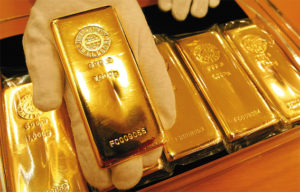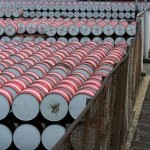 Gold swung between gains and losses on Monday and rose to the highest since September 19 in late European trading after U.S. pending home sales fell last month the most since May 2010, reinforcing speculations the Federal Reserve will refrain from trimming its quantitative easing program this year. Silver and palladium remained on negative territory, while platinum rose.
Gold swung between gains and losses on Monday and rose to the highest since September 19 in late European trading after U.S. pending home sales fell last month the most since May 2010, reinforcing speculations the Federal Reserve will refrain from trimming its quantitative easing program this year. Silver and palladium remained on negative territory, while platinum rose.
On the Comex division of the New York Mercantile Exchange, gold futures for settlement in December surged by 0.47% to a five-week high $1 358.90 per troy ounce at 14:51 GMT. Days low remained at $1 346.30 an ounce.
Gold surged to a 5-week high as the Fed seemed less likely to reduce its bond purchases this year after the National Association of Realtors reported that the number of people who signed contracts to buy previously owned homes fell in September by the most since May 2010. U.S. pending home sales plunged 5.6% and confounded analysts projection for a 0.1% increase after falling by 1.6% in August. This was a fourth consecutive decline and reflected the rise in mortgage rates, which hit two-year highs last week, after the Federal Reserve announced it will begin decelerating its monetary stimulus earlier this year.
Lawrence Yun, NAR Chief Economist, said in a statement: “This tells us to expect lower home sales for the fourth quarter, with a flat trend going into 2014. Even so, ongoing inventory shortages will continue to lift home prices, though at a slower single-digit growth rate next year.”
The negative housing data added to last weeks downbeat employment numbers, supporting broad market expectations that the Federal Reserve will refrain from scaling back its monthly bond purchases this year. According to a Bloomberg survey of 40 analysts conducted on October 17-18, the Fed will begin decelerating its monetary stimulus in March.
The National Association of Realtors reported last Monday that U.S. existing home sales fell by 1.9% to an annual rate of 5.29 million units, while prices rose at the slowest pace in five months. This was another sign that the high mortgage rates have begun to slow down the housing market recovery. August’s reading received a downward revision to 5.39 homes resold from initially estimated at 5.48 million. Economists surveyed by Reuters expected a 2.9% fall to 5.3 million units sold.
Manufacturing output rises less than projected
Also fanning negative sentiment for the U.S. economy, industrial production advanced more than analysts projected but the expansion was based on utilities and increased output by mines as higher temperatures stoked electricity demand. Industrial production rose by 0.6% in September, the most since February, exceeding both expectations and last months advance of 0.4%
But manufacturing production managed to barely rise last month after the production of computer and electronic goods fell, indicating that business spending by the end of the third quarter eased. Output at factories inched up by 0.1% and Augusts reading received a downward revision to 0.5%. Analysts surveyed by Bloomberg expected a 0.3% advance in September.
Automobile production rose by 2% in September but sharply underperformed Augusts 5.2% increase. Output at factories was held back by a 0.5% contraction in the production of computer and electronic goods.
Overall, the industrial productions expansion in September exceeded analystss projections after utilities rebounded 4.4% last month following five consecutive monthly declines. Mining output gained 0.2% but trailed Augusts 0.6% advance.
Meanwhile, the Federal Reserve reported that the Capacity Utilization Rate, which measures the percentage of production capacity being utilized in U.S. mines, utilities and factories, rose to 78.3% from 77.9% in August, surpassing economists forecast for a jump to 78.0%. However, the reading was 1.9% below its long-run average.
The U.S. dollar index, which measures the greenbacks performance against a basket of six major peers, traded at 79.37 at 14:49 GMT, up 0.13% on the day. The December contract held in range between days low of 79.21, near Fridays 13-month low, and days high of 79.45. A weak dollar makes dollar-denominated commodities cheaper for foreign currency holders and boosts their appeal as an alternative investment.
Elsewhere on the precious metals market, silver December futures traded at $22.605 per troy ounce at 14:53 GMT, down 0.14%, and held in range between days high and low of $22.708 and $22.377 an ounce respectively. Platinum for delivery in January rose by 1.14% to $1 472.05 an ounce by 14:55 GMT. The metal surged to a six-week high of $1 472.55 per troy ounce after the release of the data, while days low stood at $1 450.15 an ounce. Palladium futures for settlement in December were down 0.13% on the day and traded at $746.90 per troy ounce.





